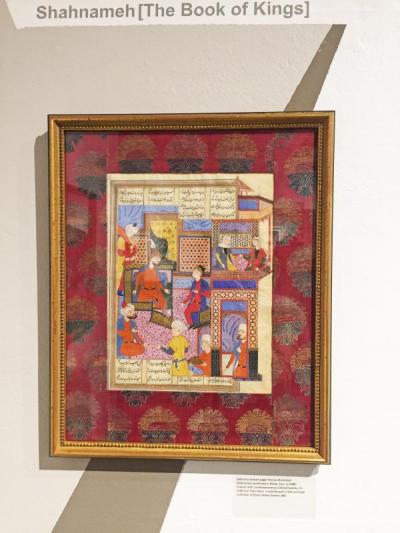From medieval to modern: Art exhibit highlights Iranian culture
Thursday evening saw the opening reception for a unique exhibit at UMass Dartmouth’s College of Visual and Performing Arts: Iranian artwork from some of the best artists in Iran and collections in Boston.
The exhibit, called ‘Contemporary Iranian Art and the Historical Imagination,’ features ancient and contemporary pieces focused around several cultural themes, including oil, 19th century Iran, modernization, and censorship and subversive action. It runs through April 1.
“The artwork here is very very top-notch artwork by Iranian artists,” said exhibit curator and UMass associate art professor Pamela Karimi. “Some of them are historic materials, including two sixteenth-century manuscripts.”
Karimi noted that she has been preparing the exhibit for about a year, with support from organizations like Boston’s rare arts library Ars Libri and help from students in her class on art and politics in the Middle East.
“My students actually participated in creating this exhibition, painting the walls, creating the sections,” she said. “Every section has its own story.”
“It’s very politically charged,” noted student Noah Tavares of the artwork. “So it’s stuff that you don’t typically see, stuff that isn’t necessarily taught in a classroom, unless it’s focused on that. So it’s a unique opportunity to see it from a different perspective.”
Another student, Bridget Bagana, spoke about censorship in the Islamic Republic.
“Censorship of the identity is very prevalent in countries like Iran and Saudi Arabia,” said Bagana. She indicated four large photos of people lounging in rooms on a wall behind her. All of the people had their faces erased.
“These four giant photos over here are actually underground parties that happened in Iran,” she said. “They’re kind of illegal, because men and women aren’t allowed to intermingle in a social setting. That’s why their faces are censored out.”
One piece, a plaster cast of part of a torso showing the artist’s breast, has the faces of women who took part in the 1979 iranian hijab protest tattooed on it.
“She made that outside of Iran,” noted Bagana. “But it’s part of her culture as well. So it kind of juxtaposes the oppression of women with something that is so revealing and daring. Something that you wouldn’t be able to find in Iran.”
The medieval manuscript pages are 16th century illustrations of Shahnameh, or the Iranian Book of Kings, an ancient epic poem detailing the myths and history of the Persian Empire.
Artist Artemis Akchoti used the poem as inspiration for her piece, which depicts the kings as she imagines them on pieces of reclaimed New England wood.
Akchoti left Iran at the age of six, growing up in Switzerland. Her art, she said, portrays a sense of lost identity and a longing to understand her native culture.
“It’s a very old book,” she said of the Book of Kings. “And it was written with a purpose. It was after the Islamic invasion of Iran, and the author was afraid that Iran would lose its culture.”
“It really gave a root to Iran,” she finished. “It is a book that also explains a lot about life.”
UMass art professor Adrian Tio was enjoying the exhibit.
“It’s quite a variety of images, and different uses of technology,” he said. “So as an artist I’m looking at the way that the media is being used in both a traditional and contemporary way.”
“I think this is brilliant,” said SOAS University anthropologist Orkideh Behrouzan, visiting from London. “This is extraordinary. It’s an amazing combination of the past and present...And I think the way that it’s presented, the narrative, is fascinating.”
“As someone who grew up in Iran, and some of this history is extremely personal to me, it’s very visceral,” she added.
“It’s a very important time right now to talk about good aspects of Iranian culture,” said Karimi. “Because unfortunately, Iran is always shown in a very very negative light in the news.”
She continued, “There’s all this discussion about war and terrorism, and this and that. But I wanted to show to my students as well as the campus community that Iranian people are strong people.”
“They produce amazing, thoughtful work against all odds,” Karimi added. “They are transforming their own culture, and they’re doing a good job on that.”



















